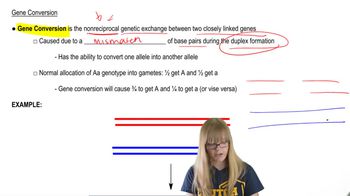Table of contents
- 1. Introduction to Genetics51m
- 2. Mendel's Laws of Inheritance3h 37m
- 3. Extensions to Mendelian Inheritance2h 41m
- 4. Genetic Mapping and Linkage2h 28m
- 5. Genetics of Bacteria and Viruses1h 21m
- 6. Chromosomal Variation1h 48m
- 7. DNA and Chromosome Structure56m
- 8. DNA Replication1h 10m
- 9. Mitosis and Meiosis1h 34m
- 10. Transcription1h 0m
- 11. Translation58m
- 12. Gene Regulation in Prokaryotes1h 19m
- 13. Gene Regulation in Eukaryotes44m
- 14. Genetic Control of Development44m
- 15. Genomes and Genomics1h 50m
- 16. Transposable Elements47m
- 17. Mutation, Repair, and Recombination1h 6m
- 18. Molecular Genetic Tools19m
- 19. Cancer Genetics29m
- 20. Quantitative Genetics1h 26m
- 21. Population Genetics50m
- 22. Evolutionary Genetics29m
4. Genetic Mapping and Linkage
Crossing Over and Recombinants
Problem 9
Textbook Question
Alleles A and a are on one pair of autosomes, and alleles B and b are on a separate pair of autosomes. Does crossover between one pair of homologs affect the expected proportions of gamete genotypes? Why or why not? Does crossover between both pairs of chromosomes affect the expected gamete proportions? Why or why not?
 Verified step by step guidance
Verified step by step guidance1
Step 1: Understand that alleles A and a are located on one pair of homologous autosomes, and alleles B and b are located on a separate, different pair of homologous autosomes. Each pair segregates independently according to Mendel's law of independent assortment.
Step 2: Recall that crossover (or recombination) occurs between homologous chromosomes during meiosis and can shuffle alleles on the same chromosome, creating new combinations of alleles on that chromosome.
Step 3: Analyze the effect of crossover on one pair of homologs (e.g., the pair carrying A and a). Since the other pair (carrying B and b) is on a different chromosome, crossover on the A/a pair does not affect the allele combinations on the B/b pair. Therefore, crossover on one pair affects only the gamete genotypes related to that pair, but not the overall expected proportions of gametes when considering both pairs together.
Step 4: Consider crossover occurring on both pairs of chromosomes. Since each pair can independently undergo crossover, recombination can generate new allele combinations on both pairs. However, because the pairs assort independently, the overall expected proportions of gamete genotypes are determined by the independent assortment of the two pairs, and crossover on both pairs will not change the expected Mendelian ratios of gametes.
Step 5: Conclude that crossover affects the arrangement of alleles on individual chromosomes but does not alter the expected proportions of gamete genotypes when alleles are on separate chromosome pairs due to independent assortment.
 Verified video answer for a similar problem:
Verified video answer for a similar problem:This video solution was recommended by our tutors as helpful for the problem above
Video duration:
1mPlay a video:
Was this helpful?
Key Concepts
Here are the essential concepts you must grasp in order to answer the question correctly.
Independent Assortment of Autosomes
Independent assortment refers to how different pairs of homologous chromosomes segregate independently during meiosis. Since alleles A/a and B/b are on separate autosomes, their segregation into gametes occurs independently, affecting the combination of alleles inherited.
Recommended video:
Guided course

Gamete Genetics and Independent Assortment
Crossover (Recombination) Within a Chromosome Pair
Crossover is the exchange of genetic material between homologous chromosomes during meiosis. It reshuffles alleles on the same chromosome pair, altering gamete genotypes by creating new allele combinations, but it does not affect alleles on different chromosome pairs.
Recommended video:
Guided course

Gene Conversion
Effect of Crossover on Gamete Genotype Proportions
Crossover between one pair of homologs changes the allele combinations on that chromosome but does not affect the independent assortment of other chromosome pairs. Therefore, crossover on one pair alters gamete proportions for that pair only, while crossover on both pairs can change allele combinations on both, influencing overall gamete genotype frequencies.
Recommended video:
Guided course

Gamete Genotypes
Related Videos
Related Practice
Textbook Question
Explain why a 50 percent recovery of single-crossover products is the upper limit, even when crossing over always occurs between two linked genes?
847
views


